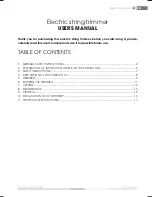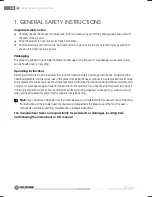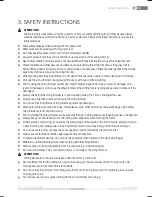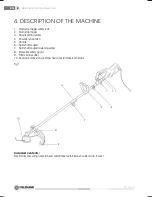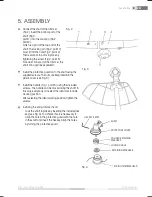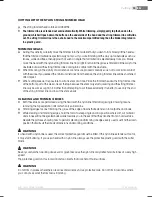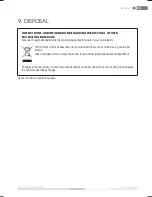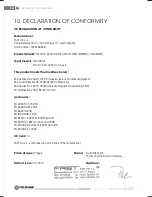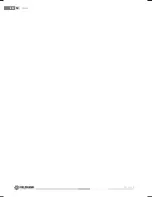
EN
14
FZS 2050-E
CUTTING USING THE BLADE
CUTTING WEEDS
This is cutting performed by a pendular movement of the blade in an arch shape. In this way you can quickly
clear a large area of dense grass and weed. Brush cutting should be used for cutting large and tough weeds
or woody vegetation.
Brush cutting may be performed in both directions or only in one direction, which will mean that the cut
material will be ejected away from you. With this type of cutting, the part of the blade moving away from you
will do the work. Slightly tilt the blade down to the same side. If you will be brush cutting in both directions,
you will be hit by some defl ected material.
Note:
Do not use the brush cutter blade for cutting trees with a diameter larger than 12 mm.
WARNING
DO NOT TOUCH THE FOLLOWING OBJECTS WITH THE BLADE:
METAL POLES, ELECTRICAL WIRE, RUBBER, MASONRY, STONES, FENCES
WARNING
Do not cut if the metal blade is blunt, cracked or damaged.
Before starting to cut, check that there are no obstacles in the work area such as rocks, metal poles or wound up
wires. If you cannot remove these obstacles, mark them out so that they do not come in contact with the blade.
Rocks or metal objects will blunt or damage the blade. Wires may wind on to the blade head or may be defl ected
and cause injuries.
8. MAINTENANCE
The string trimmer line may dry out over time. To maintain it in excellent condition, store spare pre-wound
spools or loose trimmer line in a plastic bag with a spoon of water.
For cleaning the power tool, use only gentle soap and a damp cloth. Do not submerge the power tool in
water or spray it with a hose. Do not allow any liquid to enter inside. Do not clean with pressurised water.
The trimmer line cutter on the edge of the protective guard may become blunt over time. We recommend that
it is regularly resharpened with a fi le.
Cutting | Maintenance
Summary of Contents for FZS 2050-E
Page 1: ...EN ...
Page 17: ...EN 18 FZS 2050 E Notes ...


